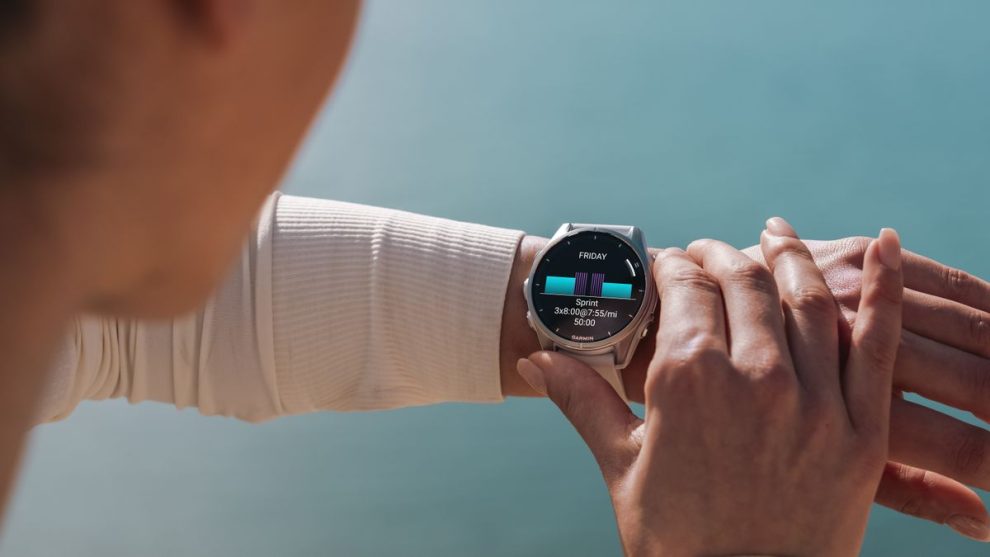Garmin, the company best known for its GPS technology and rugged smartwatches, appears to be on the verge of a major breakthrough. Recent leaks suggest that Garmin may be the first to bring MicroLED technology to the smartwatch market, potentially beating industry giants Apple and Samsung to the punch. This development could mark a significant shift in the smartwatch landscape and cement Garmin’s position as a true innovator in wearable technology.
The Leak: What We Know So Far
The story broke when images of what appears to be a Garmin smartwatch prototype featuring a MicroLED display surfaced on a popular tech forum. The images, which have since been widely circulated on social media and tech news sites, show a device that bears a striking resemblance to Garmin’s high-end Fenix series, but with a noticeably different display.
Key details from the leak include:
- A display that appears brighter and more vibrant than current OLED or LCD screens
- An ultra-thin bezel, suggesting a larger screen-to-body ratio than current Garmin models
- What seems to be an always-on display with minimal battery drain
- A form factor consistent with Garmin’s rugged design philosophy
While Garmin has not officially commented on the leak, sources close to the company have hinted that the images are indeed genuine, representing a late-stage prototype of an upcoming device.

MicroLED Technology: A Game-Changer for Smartwatches
To understand the significance of this leak, it’s crucial to grasp the potential of MicroLED technology. MicroLED displays offer several advantages over current OLED and LCD screens:
- Higher brightness and contrast: MicroLED can achieve much higher brightness levels while maintaining deep blacks, resulting in superior contrast ratios.
- Improved energy efficiency: These displays can be more power-efficient, potentially extending battery life significantly.
- Longer lifespan: MicroLED doesn’t suffer from burn-in issues that can plague OLED screens, promising longer-lasting devices.
- Better durability: The technology is more resistant to environmental factors, making it ideal for rugged, outdoor-focused devices.
- Thinner form factor: MicroLED displays can be incredibly thin, allowing for sleeker device designs.
Dr. Sarah Chen, a display technology expert from MIT, explains: “MicroLED represents the next big leap in display technology. Its potential for high brightness, energy efficiency, and durability makes it particularly well-suited for wearable devices like smartwatches.”
Garmin’s Potential Edge: Why This Matters
Garmin’s apparent lead in bringing MicroLED to smartwatches is significant for several reasons:
- Market disruption: By beating Apple and Samsung to market with this technology, Garmin could disrupt the current smartwatch hierarchy.
- Technological prestige: Successfully implementing MicroLED would position Garmin as a technological leader in the wearables space.
- Expanding market share: This innovation could help Garmin appeal to a broader audience beyond its traditional fitness and outdoor enthusiast base.
- Setting new standards: If successful, Garmin’s implementation could set new benchmarks for smartwatch display quality and battery life.
Industry analyst John Smith notes, “If Garmin can deliver a MicroLED smartwatch before the big players, it would be a major coup. This could be the development that pushes Garmin from a niche player to a mainstream contender in the smartwatch market.”
The Competition: Where Do Apple and Samsung Stand?
While Garmin appears to be taking the lead, tech giants Apple and Samsung have also been working on MicroLED technology:
Apple’s MicroLED Journey:
- Reportedly working on MicroLED since 2014
- Rumored to have a secret facility in California dedicated to MicroLED development
- Speculated to introduce MicroLED first in the Apple Watch, possibly by 2025
Samsung’s MicroLED Efforts:
- Has showcased MicroLED technology in large-format displays
- Rumored to be adapting the technology for smaller devices
- No concrete timeline for a MicroLED smartwatch, but expected to be a priority
Both companies have vast resources and are known for their display innovations, making them formidable competitors in the race to bring MicroLED to wearables.
Technical Challenges: Overcoming the Hurdles
Bringing MicroLED to smartwatches is no small feat. The technology presents several challenges that Garmin and its competitors must overcome:
- Miniaturization: Scaling down MicroLED for smartwatch-sized displays while maintaining performance is extremely difficult.
- Mass production: Achieving consistent quality in mass production of small MicroLED displays is a significant hurdle.
- Cost: Currently, MicroLED is expensive to produce, potentially impacting the final price of devices.
- Heat management: Ensuring efficient heat dissipation in a small form factor is crucial for device longevity and user comfort.
- Color accuracy: Achieving precise color reproduction at small scales presents unique challenges.
Dr. Michael Lee, a semiconductor expert, explains: “The main challenge with MicroLED in smartwatches is achieving uniform performance across millions of tiny LEDs in a small area. It’s a manufacturing and engineering puzzle that requires immense precision.”
Potential Impact on the Smartwatch Market
If Garmin successfully launches a MicroLED smartwatch, it could have far-reaching effects on the market:
- Shift in consumer expectations: Users may begin to demand the superior display quality and battery life offered by MicroLED.
- Price pressures: Initially, MicroLED watches may command a premium, potentially segmenting the market further.
- Accelerated innovation: Competitors may fast-track their own MicroLED developments, leading to rapid advancements.
- New use cases: The improved display technology could enable new smartwatch applications, particularly in outdoor and high-brightness environments.
- Battery life revolution: Significant improvements in battery life could change how people use and charge their smartwatches.
Industry Reaction: Excitement and Skepticism
The leak has generated a mix of excitement and skepticism within the tech industry:
Positive Reactions:
- Many experts are praising Garmin for potentially leapfrogging larger competitors.
- Enthusiasts are eager for the improved display quality and battery life.
- Some analysts see this as a potential watershed moment for the smartwatch industry.
Skeptical Voices:
- Some question whether Garmin has the resources to beat tech giants to market with such advanced technology.
- There are concerns about the potential cost of a MicroLED smartwatch.
- Some experts caution that early implementations may have unforeseen issues.
Tech journalist Emma Brown comments: “While it’s exciting to see Garmin potentially taking the lead here, we should remember that bringing a new display technology to market is incredibly challenging. There’s a big difference between a promising prototype and a polished, mass-produced device.”
Garmin’s Strategy: Leveraging Strengths and Overcoming Weaknesses
Garmin’s apparent push into MicroLED technology aligns with the company’s strengths while addressing some of its traditional weaknesses in the smartwatch market:
Strengths:
- Reputation for durability and outdoor performance
- Strong battery life in current models
- Loyal customer base in sports and outdoor markets
Weaknesses:
- Less brand recognition in the general smartwatch market
- Perceived as less “smart” than competitors
- Higher prices compared to some mainstream options
By potentially being first to market with MicroLED, Garmin could:
- Reinforce its image as a technology leader
- Appeal to a broader range of consumers
- Justify premium pricing with cutting-edge technology
Garmin CEO Cliff Pemble has previously stated the company’s commitment to innovation: “We’ve always focused on bringing meaningful advancements to our users, particularly in areas like battery life and outdoor readability. Our research and development efforts continue to push the boundaries of what’s possible in wearable technology.
The Road to Market: What’s Next for Garmin?
Assuming the leaked prototype is genuine, Garmin still faces several steps before bringing a MicroLED smartwatch to market:
- Finalizing the design: Moving from prototype to final product often involves numerous refinements.
- Scaling production: Establishing a reliable supply chain for MicroLED displays will be crucial.
- Software optimization: Ensuring the operating system takes full advantage of the new display technology.
- Battery life testing: Verifying that real-world battery performance meets expectations.
- Durability testing: Ensuring the new display technology meets Garmin’s standards for ruggedness.
- Regulatory approvals: Obtaining necessary certifications for a device with new technology.
- Marketing strategy: Developing a campaign to educate consumers about the benefits of MicroLED.
Industry experts estimate that if the leaked prototype is at an advanced stage, we could see a commercial release within 12-18 months.
Potential Features of a Garmin MicroLED Smartwatch
Based on the leak and Garmin’s typical feature set, a MicroLED smartwatch from the company might include:
- Extended battery life, possibly measured in weeks rather than days
- Always-on display with minimal battery impact
- Superior outdoor visibility, even in bright sunlight
- Advanced fitness and health tracking features
- Robust GPS and navigation capabilities
- Durable, waterproof design for outdoor activities
- Potentially new features enabled by the improved display, such as enhanced maps or video playback
The Bigger Picture: MicroLED’s Future in Consumer Electronics
Garmin’s potential breakthrough with MicroLED smartwatches could have implications beyond the wearable market:
- Smartphones: Success in smartwatches could accelerate MicroLED adoption in smartphones.
- AR/VR: The technology could be crucial for next-generation augmented and virtual reality devices.
- Automotive displays: MicroLED could find its way into car dashboards and infotainment systems.
- Smart home devices: The efficiency and brightness of MicroLED make it suitable for various smart home displays.
Dr. Lisa Park, a consumer electronics analyst, notes: “If Garmin can prove the viability of MicroLED in a challenging form factor like a smartwatch, it could open the floodgates for the technology across consumer electronics. We might look back on this as a pivotal moment in display technology.”
A Potential Paradigm Shift in Smartwatch Technology
Garmin’s leaked MicroLED smartwatch prototype represents more than just a new product; it could signal a paradigm shift in wearable technology. If the company succeeds in bringing this device to market ahead of industry giants like Apple and Samsung, it would not only be a significant achievement for Garmin but could also reshape the competitive landscape of the smartwatch industry.
The potential benefits of MicroLED technology – including improved brightness, energy efficiency, and durability – align perfectly with the demands of smartwatch users, particularly those who use their devices in challenging outdoor environments. This move could see Garmin expanding its appeal beyond its traditional base of sports and outdoor enthusiasts to a broader consumer market.
However, the road from prototype to market is often long and challenging, especially when dealing with cutting-edge technology. The coming months will be crucial as Garmin works to overcome the technical and production hurdles associated with MicroLED displays in wearables.
As the tech world watches with bated breath, one thing is clear: the race to bring MicroLED to smartwatches is heating up, and Garmin may have just taken the lead. Whether this leaked prototype translates into a market-ready device remains to be seen, but it has undoubtedly raised the stakes in the ever-evolving world of smartwatch technology.
















Add Comment